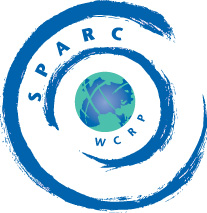 |
Stratospheric Processes And their Role in Climate
|
||||||||
| Home | Initiatives | Organisation | Publications | Meetings | Acronyms and Abbreviations | Useful Links |
![]()
 |
Stratospheric Processes And their Role in Climate
|
||||||||
| Home | Initiatives | Organisation | Publications | Meetings | Acronyms and Abbreviations | Useful Links |
![]()
In order to verify our current understanding of the role of the stratosphere in climate and to better assess future climate change, general circulation models including a detailed representation of the stratosphere are essential. SPARC through GRIPS (GCM-Reality Intercomparison Project for SPARC) has studied how well the current generation of these models simulates the current climate and its variability. In order to make a meaningful comparison with data, a comprehensive observed climatology of the means and variability of basic stratospheric parameters has been assembled.
![]()
Co-Chairs: S. Pawson (USA) and K. Kodera (Japan)
ObjectivesGRIPS aims to understand how well we can represent the coupled troposphere-middle atmosphere system in middle atmosphere climate models. These models are general circulation models that extend from the surface to the stratosphere or beyond, which attempt to represent all processes that impact the atmospheric circulation and structure. GRIPS has three concurrent 'phases' each of which poses specific questions: Phase 1 asks how well the different models perform; Phase 2 examines some of the model components in detail; Phase 3 compares the response of the models to perturbations in the physical forcing mechanisms (such as volcanic aerosol loading, solar variability, and ozone changes). A very important question, motivating the Phase-3 studies, is how well can models represent climate variability over the past two decades? Key findingsMany of the activities in Phase 1 of GRIPS are complete or are nearing completion. It was shown that most models have a cold bias at all levels (see Figure) and this has prompted an investigation of the performance of radiation schemes. The models display considerable differences in their ability to simulate the quasi-stationary wave structure in the troposphere and stratosphere. To understand the interannual variability, at least 20 years of integration are required, which is just becoming possible for many of the participating models. Travelling waves in the tropics differ vastly between the models, a result partly due to different representation of convective processes and partly due to model formulation. The models show very different spectra of resolved gravity waves, which have an important impact on what we attempt to parameterise. |
|||||
Ongoing activitiesPhase 2 research is examining the radiation schemes and the representation of gravity wave drag in the models. Off-line comparisons using identical temperature and trace gas fields reveal large differences between the radiation schemes presently used. Tests of gravity wave drag are beginning. Phase 3 studies the impacts of different forcing anomalies. Volcanic aerosols in the tropical lower stratosphere lead to perturbations to the radiative balance and induce a response in the extratropical stratosphere and troposphere in winter, an effect which is captured in some models. Changes in solar incoming radiation on 11-year timescales, coupled with their induced ozone changes, lead to a response in all models tested, but this can differ between the models. AchievementsTwo papers have appeared in the refered literature (Koshyk et al., and Pawson et al.) and several others are planned. Papers have been presented at international conferences. One of the most important achievements of GRIPS has been the success of the annual workshops, which provide a much-needed forum for informal discussion of the latest results and uncertainties of present day models. Future PlansThe main plan is to complete what we have started: Phase 1 should be wrapped up by 2002 and the scientifically relevant impact studies of Phase 3 should be studied in much more detail. To date, GRIPS has given little attention to aspects of chemistry, which will be an avenue to explore as our understanding of dynamics and physics becomes more thorough. |
|||||
|
|||||
|
Reference: J.N. Koshyk, et al., The kinetic energy spectrum of horizontal motions in middle atmosphere models, J. Geophys. Res., 104, 27177-27190, 1999. S. Pawson, K. Kodera, et al., The GCM-reality inter-comparison project for SPARC (GRIPS):
scientific issues and initial results, B.A.M.S., 81 (4), April 2000. |
|||||
Chair: W. Randel (USA)
|
||||||||||||
ObjectivesIn order to make a meaningful comparison of models with data, a comprehensive observed climatology of the means and variability of basic stratospheric parameters has been assembled. This work was needed for GRIPS, as well as for a number of other SPARC initiatives. Ongoing activitiesIn the last few years, the SPARC Climatology group has compiled a series of monthly global climatologies of temperature, zonal winds, and various atmospheric trace constituents (N2O, O, CH4, H2O, O3, NO2, HNO3, etc.) which have been assembled from NCEP, UARS and other data. Monthly and daily stratospheric circulation statistics have been inferred from available stratospheric analyses or reanalyses. Other data compiled include upper-level radiosonde winds as an indicator of the phase of the QBO and statistics on tropopause height. These data sets are now accessible from the SPARC Data Centre. Future PlansA SPARC report describing the data sets, comparing stratospheric circulation statistics, and quantifying uncertainties and interannual variability will be published in 2001. Plans for the near future are:
|
||||||||||||
|
||||||||||||
|
Reference: |
||||||||||||